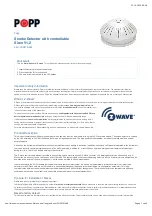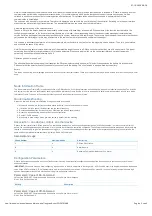
07-10-2020 09
:
28
Pagina 3 van 5
http://manual.zwave.eu/backend/make.php?lang=en&sku=POPE701486
Note: All communication of the wireless module is carried out at the application level, provided that the device is included in "Secure" mode and all other
communication partners also support secure transmission. If it is communicating with a device that does not support secure transmission, it will be
switched to an unsecure connection for communication with that device. This process takes about 20 seconds and is performed the first time
communication is established.
The siren can also be used for other alarms. Therefore it is displayed as a switch in the user interface of the controller. Switching on in the user interface
starts the siren while switching off stops the siren. The generated alarm has the same effect as the real alarm.
Automatic radio meshing of the smoke detectors
Thanks to Z-Wave, the smoke detectors automatically communicate with each other in the same Z-Wave network (if the function is activated via the
configuration parameters). In the event of an alarm (battery low or smoke), the corresponding detector sends encrypted messages (command alarm
version 2 within a package of the command class Security) to all other detectors within radio range. These in turn send the signal to detectors that have not
yet received the alarm signal. In this way, all detectors in the radio network are reached and can warn of the danger.
It is possible to deactivate the alarm on all smoke detectors to which the alarm is sent, but not on the triggering smoke detector. To do this, you must find
and eliminate the cause of the alarm.
Note: For networking several smoke detectors, all of them must be taught-in once to a Z-Wave controller so that they are all in one network. This type of
networking is not suitable for larger numbers (>3) of smoke detectors. Please use a logical link via the central controller and switch off automatic
networking with configuration parameters 5 and 6.
Operation with power supply unit
The additionally available power supply unit supplies the Z-Wave wireless module with power. This significantly extends the battery life in the detector.
Please note that the detector itself will continue to function only with the battery. The siren function is also powered by the battery.
Battery:
The status of the battery is not displayed and sent to the controller for technical reasons. There is only a battery warning which is audible for at least 30 days by a short
beep.
Node Information Frame
The Node Information Frame (NIF) is the business card of a Z-Wave device. It contains information about the device type and the technical capabilities. The inclusion
and exclusion of the device is confirmed by sending out a Node Information Frame. Beside this it may be needed for certain network operations to send out a Node
Information Frame. To issue a NIF execute the following action: Press the inclusion button (3) once.
Quick trouble shooting
Here are a few hints for network installation if things dont work as expected.
1. Make sure a device is in factory reset state before including. In doubt exclude before include.
2. If inclusion still fails, check if both devices use the same frequency.
3. Remove all dead devices from associations. Otherwise you will see severe delays.
4. Never use sleeping battery devices without a central controller.
5. Dont poll FLIRS devices.
6. Make sure to have enough mains powered device to benefit from the meshing
Association - one device controls an other device
Z-Wave devices control other Z-Wave devices. The relationship between one device controlling another device is called association. In order to control a different
device, the controlling device needs to maintain a list of devices that will receive controlling commands. These lists are called association groups and they are always
related to certain events (e.g. button pressed, sensor triggers, ...). In case the event happens all devices stored in the respective association group will receive the
same wireless command wireless command, typically a 'Basic Set' Command.
Association Groups:
Group Number
Maximum Nodes
Description
1
4
Z-Wave Plus Lifeline
2
4
Alarm Reports
3
4
Switching Commands (Basic on/off) on Alarm
Configuration Parameters
Z-Wave products are supposed to work out of the box after inclusion, however certain configuration can adapt the function better to user needs or unlock further
enhanced features.
IMPORTANT:
Controllers may only allow configuring signed values. In order to set values in the range 128 ... 255 the value sent in the application shall be the desired
value minus 256. For example: To set a parameter to 200
it may be needed to set a value of 200 minus 256 = minus 56. In case of a two byte value the same logic
applies: Values greater than 32768 may needed to be given as negative values too.
Parameter 3: Value of On-Command
Value of the BASIC SET Command send to Association Group 3 when Alarm happens
Size: 1 Byte, Default Value: 99
Setting
Description
Parameter 4: Value of Off-Command
Value of the BASIC SET Command send to Association Group 3 when Alarm is reset
Size: 1 Byte, Default Value: 0























